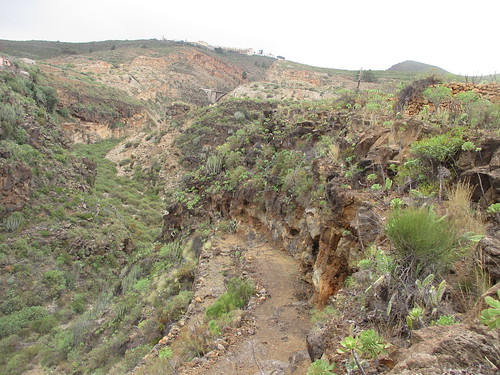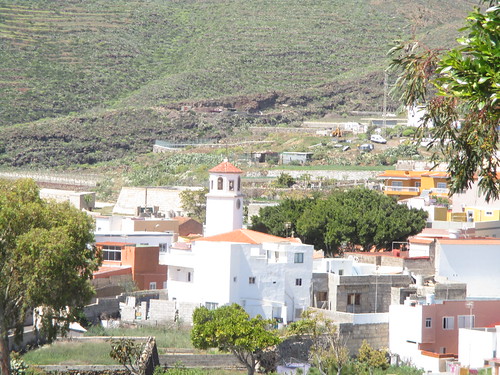
A 460 metres drop from a modern concrete bridge gave me a tempting reminder of the Barranco La Orchilla ravine as it snaked its way down from Granadilla to San Miguel. It was a relatively cool June day as the Titsa bus delivered me further uphill to the basic Granadilla bus station from my Los Cristianos start. Now for the fun part as I retraced the bus wheels before begining a spiralling trek into the ravine, pushing the bridge to the edge of my vision as my feet tried to be nimble among the loose stones and trailing ferns.


The top half of the walk was a split of modern concrete and an untamed growth of long grass and remains of cereal crops trailing away to the sun kissed coast of El Medano. Charco del Pino provided a delightful interuption as I walked up to the mirador view point behind the small church of San Luis Rey de Francia. The spread of stone dwellings and a steep walkway down to a smaller point of reflection over the largely unchanged views harked back to the importance of the Camino Real royal route that spread commerce between Granadilla and the south.



The barranco a few yards beyond was the big draw for me. A well worn path teased me along at a gentle descent before opening up to the steeper sides and and uneven surfaces. Even the air seemed to change, warmer and full of the buzz of insects, many flies took a closer interest in me in small swarms – fair play as I was disturbing their world. Lichens are a big star in the Tenerife barrancos, clinging to precarious rocks in an array of green and yellow shades. Cochineal insects living on cactus plants put the Canary Islands on the rag trade map in the 19th century, secreting natural colour dyes, but lichens weren´t far behind and also boosted trade.

The small plant like life lichens clung to every rock and bush, and around me down in the bowl of the barranco. Their value has long been replaced with artificial colourings but they still live in happy retirement in the more remote areas of Canarian land. Cactus flowers speckled my progress down the steep side before I hit rock bottom where soft echoes of bird song added to the serene feel. Having done the walk before, my eyes soon found the outline of the upward trail to the lip of the ravine. This ascent brought its own challenges as powder dry earth filtered away under foot. Looking back from the other side of the track confirmed my appreciation of nature´s alluring mix.

Meanwhile up top, the modern road curled the long way through high sided rock faces which were drilled out mechanically in recent time of expansion in Tenerife. The barking of dogs told me that there were small farms at the top of the ravine side, rural areas still feature many variations on old pursuits. Cresting the hill, a choice of gravel tracks leading to the modern main road meant my feet would soon get some rest. The margins are tight for walkers using these driving routes so caution and agility are useful. Even in this final stretch there was another joy in the sculpted shape of hunting dogs, a fitting link to a still popular past time.

San Miguel was just a few more strides away with its choice of bars and cafes to quench the first from the two hour escapade. As always, it was a pleasure to dip into the heritage of Tenerife to discover how hard work propelled the local economy.